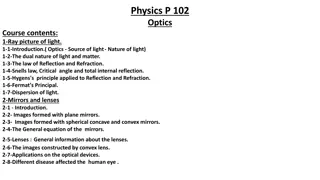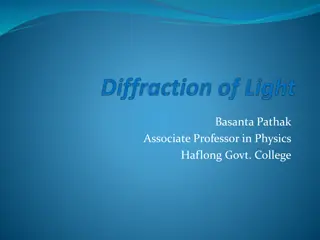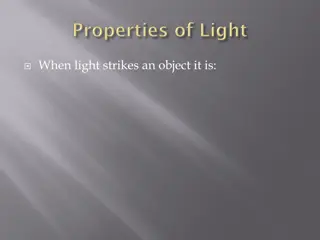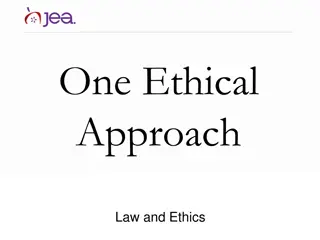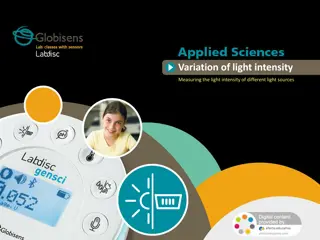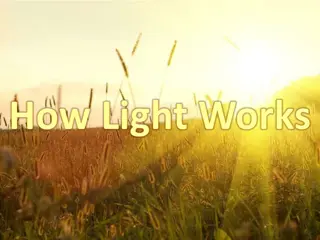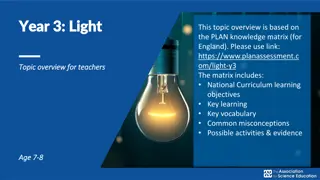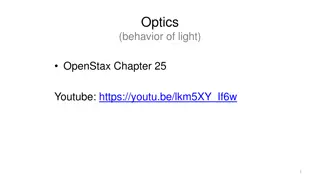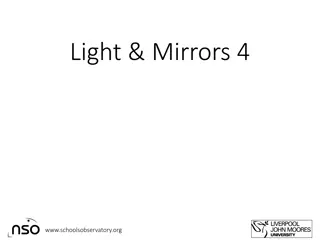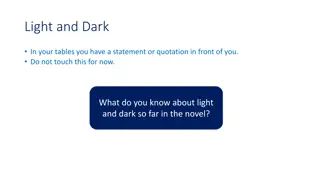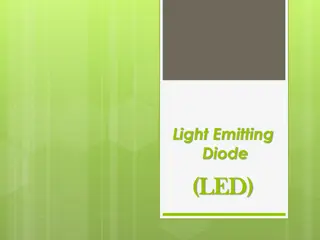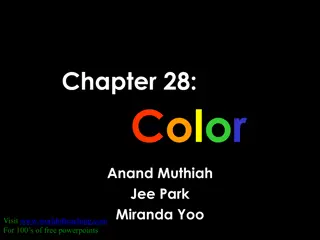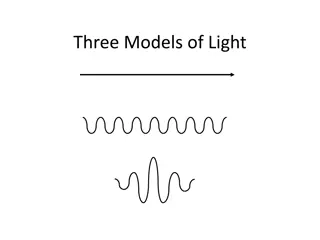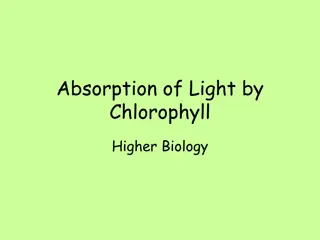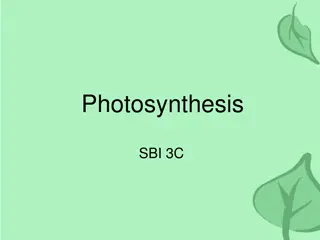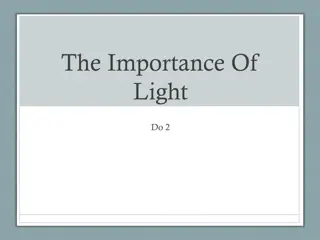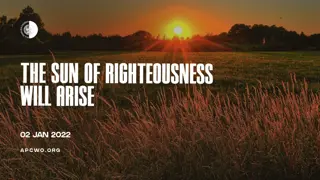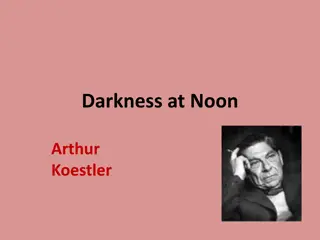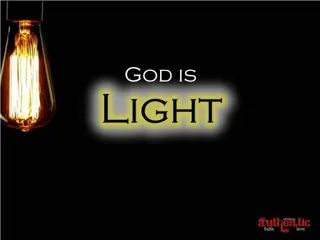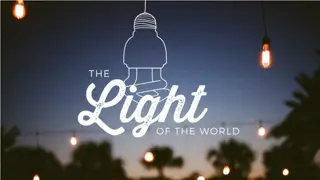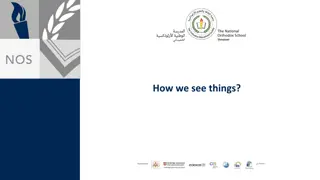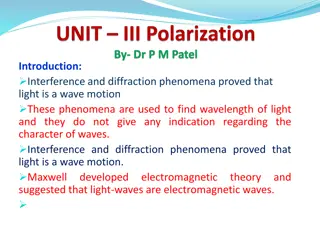Exploring Optics: Light Behavior and Properties
Optics studies the behavior of light, its interaction with matter, and the construction of instruments using or detecting light. From the dual nature of light to the laws of reflection and refraction, this branch of physics delves into topics like mirrors, lenses, and the dispersion of light. Practi
2 views • 15 slides
Understanding Prism Terminology and Light Deviation
Prisms are optical devices that deviate light without changing its vergence. This module explores the various terminology associated with prisms, including Apex, Base, Refracting Angle, and Angle of Deviation. The passage of light through a prism follows Snell's Law, where the ray is deviated toward
4 views • 42 slides
Understanding Diffraction of Light: Types and Distinctions
The propagation of light according to the wave theory involves diffraction, where light waves exhibit bending around obstacles, causing a decrease in intensity. There are two main types of diffraction - Fresnel's and Fraunhofer's, each characterized by different conditions and behaviors. The distinc
1 views • 7 slides
Workers Compensation Solutions for Light Duty Job Assignments
Learn effective solutions for Workers Compensation Light Duty job assignments. This guide provides strategies to create and implement light-duty roles, helping injured employees return to work safely and efficiently. Understand essential benefits and best practices for managing light-duty assignment
9 views • 4 slides
Understanding the Interaction of Light with Objects
When light strikes an object, it can be reflected, transmitted, or absorbed, depending on the material of the object. Transparent materials allow light to pass through, translucent materials scatter light, and opaque materials absorb and reflect light. The color of objects is the color they reflect,
6 views • 17 slides
Overview of Optical Fibre Technology and Applications
Optical fibre technology, spearheaded by Dr. Prabodh Sahai Saxena, revolutionizes communication systems through light transmission. This cutting-edge technology utilizes fibre optics made of glass or plastic to carry light signals, offering advantages like high bandwidth, low signal loss, and no ele
0 views • 20 slides
Evolution of Light Theory: From Wave Theory to Quantum Theory
At the turn of the century, the discovery of the photoelectric effect challenged the wave theory of light, leading to the development of the quantum theory by Max Planck and Albert Einstein. This new theory introduced the concept of discrete energy units known as quanta, bridging the gap between wav
1 views • 62 slides
Light Tracking Servo System Using Cadmium Sulfide Resistors
Introduction to an Arduino-based light tracking system using Cadmium Sulfide light-dependent resistors. The system tracks the maximum light intensity and automatically adjusts its direction towards the brightest source. It includes an Arduino-based Lux Meter and specifications such as DAC resolution
0 views • 7 slides
Ethical Approaches in Journalism: Red Light vs. Green Light Ethics
Explore the contrasting perspectives of Red Light and Green Light ethics in journalism, where Red Light focuses on caution and restraint while Green Light emphasizes action and opportunity. Dive into the nuances of ethical decision-making in journalism and consider the impact of language on ethical
0 views • 13 slides
Understanding Light Intensity Variation in Different Sources
Explore the correlation between light intensity and efficiency in various light sources through an intriguing experiment. Delve into the theoretical framework and practical applications to grasp the essence of light intensity and its distribution. Uncover the factors influencing the efficiency of li
0 views • 21 slides
Understanding Young's Double-Slit Experiment and Interference Patterns
Thomas Young's double-slit experiment in the late 1700s provided evidence of light behaving as a wave, showcasing interference patterns. This experiment challenged the particle theory of light and supported the wave theory. The interference patterns observed helped scientists grasp the wave nature o
0 views • 27 slides
Walking from Darkness to Light: Ephesians 5:1-14 Perspective
Explore the transformation from walking in darkness to living in light as highlighted in Ephesians 5:1-14. Through vivid storytelling and insightful reflections, the passage emphasizes the importance of following the light, exemplified by lighthouses, as a guide for living a life of love, righteousn
1 views • 42 slides
Understanding the Message of Thomas Rhett's Song "Be a Light
Thomas Rhett's song "Be a Light" conveys a powerful message of positivity and encouragement during dark times. The lyrics urge listeners to spread peace, love, and kindness, becoming a beacon of hope in a world filled with hate. This analysis explores the significance of being a light in darkness, d
0 views • 5 slides
Understanding Light Intensity: Measuring Different Light Sources
Explore the concept of light intensity by measuring various light sources and their efficiency. Through practical experiments, understand the relationship between light intensity and the output of different light sources. Theoretical frameworks, practical applications, and key concepts are discussed
0 views • 21 slides
Understanding Light: Basic Properties and Interactions
Explore the fundamental properties of light such as its speed compared to sound, the formation of shadows, and how we see things through reflection. Dive into types of light interactions like refraction and reflection, understanding how light behaves when passing through different mediums and intera
0 views • 27 slides
Understanding Light, Shadows, and Reflection in Science
Light is a vital form of energy that helps us see objects. Luminous objects emit light, while non-luminous objects do not. Understanding how light interacts with objects, creating shadows and reflections, is crucial in science. Transparent objects allow light to pass through, translucent objects all
0 views • 13 slides
Understanding Light: Key Concepts for Year 3 Students
Delve into the world of light with Year 3 students through engaging activities and explorations. Learn about sources of light, shadows, reflective surfaces, and the importance of light for vision. Discover how light helps us see and how shadows are formed, while exploring materials and objects that
0 views • 9 slides
Understanding the Behavior of Light in Optics
Light in optics can be described as a wave, a particle, or a ray. The ray model of light explains how light travels in straight lines unless it interacts with a surface or changes media. By tracing rays back, we can locate objects and understand how light interacts with matter at boundaries between
0 views • 39 slides
Analysis of "Hotel Room, 12th Floor" by MacCaig
An in-depth analysis of the poem "Hotel Room, 12th Floor" by MacCaig, written in 1966. The poem delves into broader questions about humanity, contrasting technological progress with past and present aggression in American society. It explores the balance between light and dark, good and evil, and th
0 views • 29 slides
Joseph Conrad: A Brief Biography and Exploration of Themes in "Heart of Darkness
Joseph Conrad, a Polish-British writer, led a fascinating life as a merchant mariner before becoming a renowned author. His notable works include "Heart of Darkness," a novel exploring the complexities of imperialism and the human condition. Through Conrad's experiences and writings, profound ideas
0 views • 23 slides
Exploring Light and Mirrors: Investigations and Discoveries
Delve into the world of light and mirrors as we investigate angles of reflection, examine how mirrors affect the perception of objects, and explore the use of periscopes in observing underwater. Discover the rules governing the reflection of light beams and unravel the mysteries of how mirrors manip
0 views • 11 slides
Exploring Light and Dark Themes in Steinbeck's Novella
Delve into the symbolism of light and dark in John Steinbeck's novella, analyzing how they are used to represent characters and themes. Understand the significance of characters associated with light and darkness, and explore the societal implications of these contrasts. Practice writing paragraphs
0 views • 4 slides
Understanding Light Emitting Diodes (LEDs)
Light Emitting Diodes (LEDs) are semiconductor devices that convert electrical energy into visible or invisible light. They are constructed using gallium, phosphorus, and arsenic materials instead of silicon or germanium. The recombination process in forward bias condition is crucial for the operati
0 views • 19 slides
Navigating Together in the Light of Christ
Explore the importance of fellowship, vigilance, and encouragement among believers as discussed in 1 Thessalonians 5. Reflect on the contrasts between light and darkness, and how faith, love, and salvation serve as protective armor in a world becoming increasingly dark. Discover how we can support e
0 views • 21 slides
Understanding Color: A Comprehensive Overview
Color is a fascinating aspect of our visual world, explored through the prism of science and light. This chapter delves into the origins of color perception, from Isaac Newton's study of the color spectrum to the reflection and transmission of light that determines how we see colors. Gain insights i
0 views • 28 slides
Exploring Darkness and Light: Biblical Contrasts in Life's Experiences
Delve into the profound contrasts of darkness and light as depicted in the Bible, reflecting on the brightest and darkest moments of life. From the formless void to the separation of light and darkness, the journey unfolds through biblical narratives in Romans and Genesis, illustrating the eternal s
0 views • 35 slides
Understanding Sources of Light and Reflection
Exploring the concept of light sources and reflection, the article delves into how light is created by various objects like the sun, light bulbs, and fires. It explains the difference between sources of light and objects that reflect light, such as shiny metal surfaces. The reader is encouraged to i
0 views • 14 slides
Light the Candle of Peace - Music and Words by Audrey Snyder
Amidst the darkness and conflicts of the world, "Light the Candle of Peace" by Audrey Snyder reflects on the power of unity, compassion, and hope. Through the symbolic act of lighting a candle, the song highlights the importance of spreading peace and harmony in times of trouble and war. Let the gol
0 views • 9 slides
Exploring Models of Light: Ray Model and Wave Model
This informative content delves into the Ray Model of Light, discussing how light travels in straight lines known as rays and how it can be made visible. It also explores the Wave Model of Light, covering topics like diffraction and the reasons why we often do not notice it. Additionally, the text t
0 views • 9 slides
Understanding Light Absorption by Chlorophyll in Biology
Explore how chlorophyll absorbs light in photosynthesis, the role of different types of seaweeds, and the use of spectrometers to measure light absorption. Discover the specific light regions absorbed by chlorophyll A and B, as well as adaptations in seaweeds for varying light intensities. Learn abo
0 views • 9 slides
Understanding Photosynthesis: The Process of Energy Conversion in Plants
Photosynthesis is a vital process where plants, algae, and cyanobacteria convert light energy from the sun into chemical energy in the form of glucose. This energy conversion involves the absorption of light by chlorophyll molecules in chloroplasts, leading to the generation of ATP and the formation
0 views • 12 slides
Investigating the Role of Light in Photosynthesis
Explore the significance of light in photosynthesis through a structured scientific investigation involving plants, testing the necessity of factors like carbon dioxide, water, and light. Follow a hypothesis-driven approach to observe the production of oxygen in plants exposed to light versus dark c
0 views • 12 slides
Embrace the Light: A Journey to Conquer Giants and Claim Your Inheritance
Unveil the guidance from the Word of the Lord for 2022, urging you to take your mountain, conquer your giants, and occupy your inheritance. Drawing wisdom from Joshua and Psalms, embrace faith, rise above unbelief, wholly follow God, keep yourself strong, and let His righteousness break forth into y
0 views • 15 slides
Analysis of "Darkness at Noon" by Arthur Koestler in Context of Russian Revolution and Succession
Explore the metaphoric context of "Darkness at Noon" by Arthur Koestler in relation to the Russian Revolution of 1917, succession issues following Lenin's rule, and the thematic elements of guilt, intention, and historical necessity within the Party's evaluation. Dive into the dramatis personae, int
0 views • 7 slides
Embracing the Light: Message of Fellowship and Forgiveness
Embrace the message that God is light and in Him there is no darkness. Walking in the light brings fellowship, cleansing from sin, and forgiveness. Confessing our sins leads to God's faithful forgiveness and cleansing. Jesus Christ is our advocate and the propitiation for our sins. Let the light gui
0 views • 14 slides
Revelations of Light and Darkness in Biblical Scriptures
Explore a collection of verses from the Bible that delve into the themes of light and darkness, showcasing the contrast between the glory of God's light and the mysterious nature of darkness. From Psalms to Revelation, these passages offer profound insights into the divine presence revealed in diffe
0 views • 28 slides
The Light of Life: A Visual Journey Through Light and Darkness Scriptures
Explore the profound symbolism of light and darkness in spiritual contexts through a collection of visually appealing images and corresponding verses from the Bible. Witness the transformative power of light, guiding believers from darkness to enlightenment and freedom.
0 views • 13 slides
Understanding Light: How We See and Interact with Objects
Explore the fascinating world of light and vision, from how light travels in straight lines to how we perceive objects. Learn about luminous and nonluminous objects, the different categories of light sources, and the vocabulary associated with light interactions. Delve into the concepts of emitting,
0 views • 7 slides
Factors Affecting Algal Ecology: Light Intensity Impacts on Algae Growth and Composition
Light intensity plays a crucial role in the growth and composition of algae. Algae undergo photoadaptation processes to adjust to varying light levels, affecting their photosynthetic efficiency and cellular properties. High light intensity can lead to photoinhibition and changes in cellular composit
0 views • 19 slides
Understanding Light Wave Polarization and Brewster's Law
Interference and diffraction phenomena demonstrate light as wave motion, leading to insights on wave nature. Maxwell's electromagnetic theory supports light as transverse waves. Learn about polarization of light waves, production methods, and applications in industry. Explore the discovery of light
0 views • 89 slides
